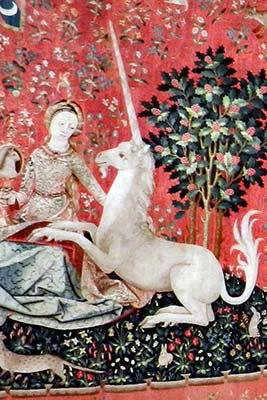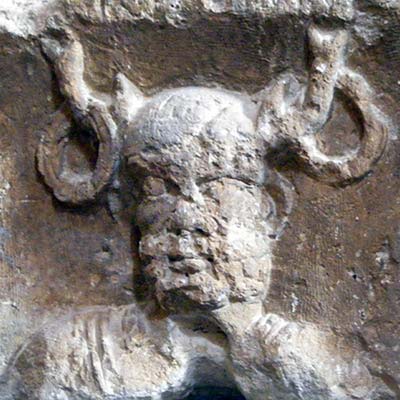
Musée National du Moyen Age
Lady and the Unicorn Tapestries
The National Museum of the Middle Ages doesn’t sound quite so boring as I sink deeper into middle age myself. Aside from the solemn religious art, there’s some surprisingly lively stuff here.
Paris emerged on the world stage in the Middle Ages, the time between ancient Rome and the Renaissance. Europe was awakening from a thousand-year slumber. Trade was booming, people actually owned chairs, and the Renaissance was moving in like a warm front from Italy.
Cost: €9, includes audioguide, free on first Sun of the month, covered by Museum Pass.
Hours: Wed-Mon 9:15-17:45, closed Tue.
Information: +33 1 53 73 78 00, www.musee-moyenage.fr.
Renovation: The museum is closed for a major renovation until at least fall 2021.
Getting There: The museum, a five-minute walk from Ile de la Cité, is a block above the intersection of Boulevards St. Germain and St. Michel, at 6 Place Paul Painlevé (Mo: Cluny La Sorbonne, St-Michel, or Odéon; bus #63 from Rue Cler and #86 or #87 from the Marais).
Length of This Tour: You can see the highlights—the Roman Bath and the Lady and the Unicorn tapestries—in less than an hour, but definitely allow browsing time for this underrated museum.
Baggage Check: Required and free for bags larger than a purse.
Cuisine Art: Just a few blocks away, the charming Place de la Sorbonne has several good cafés (see here; walk up Boulevard St. Michel toward the Panthéon). The peaceful square facing the museum entry has flowers, children playing, and plenty of picnic benches. To eat or drink with a smashing view of the Panthéon, walk a few blocks farther and find Le Soufflot (16 Rue Soufflot).
Because the museum’s makeover is still in flux, this chapter is less a room-by-room tour and more a chronological overview of the highlights.
• First up is the biggest, oldest, and most venerable part of the museum—the 2,000-year-old...
This echoing cavern was a Roman frigidarium. Pretty cool. The museum is located on the site of a Roman bathhouse, which was in the center of town during the Roman years. The sunken area you see in the alcove was exactly what it looks like: a swimming pool. After hot baths and exercise in adjoining rooms, ordinary Romans would take a cold dip there, then relax cheek to cheek with such notables as Emperor Julian the Apostate (see his statue), who lived next door. As the empire decayed in the fourth century, Julian avoided the corrupt city of Rome and made Paris a northern power base.
The 40-foot-high ceiling is the largest surviving Roman vault in France, and it took the French another 1,000 years to improve on that crisscross-arch technology. The sheer size of this room—constructed in AD 200, when Rome was at its peak—gives an idea of the epic scale on which the Romans built. It inspired Europeans to greatness during the less civilized Middle Ages.
• Among the ruins that littered medieval Paris after the fall of Rome was the...
Four fragments remain of the Pillar of the Boatmen (Le Pilier des Nautes), which decorated the ancient Roman temple to Jupiter that stood where Notre-Dame is today. These fragments, probably the oldest man-made objects you’ll see from Paris, once fit together to support a 20-foot-high altar to the king of the gods in the Roman temple. Take a closer look at three of these:
One fragment (the pierre de la dédicace, or dedication stone) is inscribed “TIB. CAESARE,” announcing that the altar was built under Emperor Tiberius (AD 14-37; he reigned during the time of Jesus Christ) and was paid for by the Parisian boatmen’s union (see them holding their shields).
Another fragment (the Pierre aux quatre divinités) depicts the horned Celtic god Cernunnos, who is also known as the Stag Lord and god of the hunt. The eclectic Romans allowed this local “druid” god to support the shrine of Jupiter in league with their own Vulcan, who hammers, and Castor and Pollux, who pet their horses.

The fragment labeled Bloc dit “de Jupiter” shows Jupiter in his royal robes leaning on a spear, as well as the god Vulcan hammering in his fiery forge.
• The museum leads you from the fall of Rome (AD 476) to France’s next chapter, beginning with the reign of the Frankish king Clovis I, the father of modern France.
The museum’s exquisite collection of objects from c. 500-1000 make it clear that Roman art and learning lived on even after the empire’s fall. Columns and capitals evoke the Roman-esque grandeur of early Christian churches. Statues of the Virgin Mary, decorative flourishes from church buildings, and exquisitely carved miniature altarpieces in ivory reveal Roman style and artistic techniques.
• Throughout your visit, you’ll see stunning examples of...

At a time when life could be harsh and brutal, stained glass gave people a glimpse of the glories of heaven. The panels displayed here once adorned some of Paris’ most venerable churches, such as St. Denis (the world’s first truly Gothic church) and the glorious Sainte-Chapelle. Some are rare 800-year-old originals that were removed during renovations and replaced. They give us a window into the magical, supernatural, miraculous—and often violent—medieval mind.

Around the year 1200, Parisians were emerging from the Dark Ages. They’d survived their Y1K crisis, trade was booming, a university was founded (today’s Sorbonne), and Paris was becoming a major European capital. The High Middle Ages produced art that was less about grim crucifixions and more a celebration of the beauty of the world. You’ll see surprisingly joyful tapestries, golden altarpieces, statues with a budding realism, and inviting Madonnas with smiles and sashaying hips. One ivory box (c. 1300), finely carved from an elephant tusk, gives a look at the age of courtly love, with ladies shooting flowers as arrows and a tournament shown as a battle for love.
The Cluny has some treasured artifacts from the High Middle Ages’ most famous cathedral—Notre-Dame. Twenty-one stone heads (sculpted 1220-1230), depicting the biblical kings of Judah, once sat atop statues decorating the front of the cathedral. In 1793 an angry mob of revolutionaries, mistaking the kings of Judah for the kings of France, abused and decapitated the statues. (Today’s heads on the Notre-Dame statues are reconstructions.) Someone gathered up the heads and buried them in his backyard near the present-day Opéra Garnier. There they slept for two centuries, unknown and noseless, until 1977, when someone accidentally unearthed them and brought them to an astounded world. Their stoic expressions accept what fate, time, and liberals have done to them.

A statue of Adam is also from Notre-Dame. It will be another 200 years before naked Adam, scrawny and flaccid, can step out from behind that bush.
• As Europeans rediscovered the beauty of the world around them, a new sensuality crept into their artwork. A marvelous celebration of the senses—and the high point of the Cluny’s collection—is the late medieval masterpiece known as the...
Designed by an unknown (but probably French) artist before 1500, these six tapestries were woven in Belgium from wool and silk. Loaded with symbols—some serious, some playful—they have been interpreted in many ways, but, in short, the series deals with each of the five senses.
In medieval lore, unicorns were enigmatic, solitary creatures, so wild that only virgins could entice and tame them. In secular society, they symbolized how a feral man was drawn to his lady love. Religiously, the unicorn was a symbol of Christ—radiant, pure, and somewhat remote—who is made accessible to humankind by the Virgin Mary. These tapestries likely draw inspiration from all these traditions.
• Moving clockwise around the room...

Touch: This is the most basic and dangerous of the senses. The scene is set in the wild: monkeys, a leopard, and exotic birds. A blond lady “strokes the unicorn’s horn”—if you know what I mean—and the lion gets the double entendre. Medieval Europeans were exploring the wonders of love and the pleasures of sex.
Taste: The lady takes candy from a servant’s dish to feed it to her parakeet. A unicorn—a species extinct since the Age of Reason—and a lion look on. At the lady’s feet, a monkey also tastes something, while the little white dog behind her wishes he had some. This was the dawn of the Age of Discovery, when overseas explorers spiced up Europe’s bland gruel with new fruits, herbs, and spices.
The lion (symbol of knighthood?) and unicorn (symbol of “bourgeois nobility,” purity, or fertility?) wave flags with the coat of arms of the family that commissioned the tapestries—three silver crescents in a band of blue.
Smell: The lady picks flowers and weaves them into a sweet-smelling wreath. On a bench behind, the monkey apes her. The flowers, trees, and animals are exotic and varied. Each detail is exquisite alone, but if you step back they blend together into pleasing patterns.
Hearing: Wearing a stunning dress, the lady plays sweet music on an organ, which soothes the savage beasts around her. The pattern and folds of the tablecloth are lovely. Humans and their fellow creatures (cats, dogs, and rabbits) live in harmony in an enchanted blue garden filled with flowers, all set in a red background.
Sight: The unicorn cuddles up and looks at himself in the lady’s mirror, pleased with what he sees. The lion turns away and snickers. As the Renaissance dawns, vanity is a less than deadly sin.
Admire the great artistic skill in some of the detail work, such as the necklace and the patterns in the lady’s dress. This tapestry had quality control in all its stages: the drawing of the scene, its enlargement and transfer to a cartoon, and the weaving. Still, the design itself is crude by Renaissance 3-D standards. The fox and rabbits, supposedly in the distance, simply float overhead, as big as the animals at the lady’s feet.
Tapestry #6: The most talked-about tapestry gets its name from the words on our lady’s tent: A Mon Seul Désir (To My Sole Desire). What is her only desire? Is it jewelry, as she grabs a necklace from the jewel box? Or is she putting the necklace away and renouncing material things in order to follow her only desire?

Our lady has tried all things sensual and is now prepared to follow the one true impulse. Is it God? Love? Her friends the unicorn and lion open the tent doors. Flickering flames cover the tent. Perhaps she’s stepping out from the tent. Or is she going in to meet the object of her desire? Human sensuality is awakening, an old dark age is ending, and the Renaissance is emerging.
Allow time to explore more of this wide-ranging museum. You’ll find medallions, more tapestries, medieval altarpieces, old books, swords and guns, and even a narwhal tusk—in medieval times, these were sold as unicorn horns. Ah, the joys of the Middle Ages.

• When you’re ready, leave the Middle Ages and return to your modern, fast-paced life...